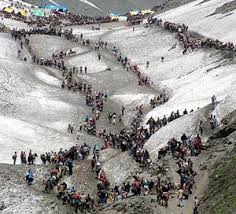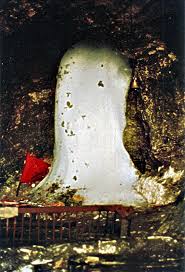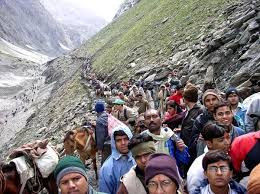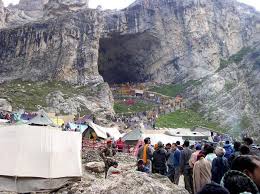AMARNATH PACKAGES www.tycoon-holidays.com
CUSTOMER CARE: +91-9717416541



 \
\
Exact period in not known when AmarnathYatra took start. According to Puran, Bhrigu Rishi visited Amarnath Cave. In the Maurya dynesty, Kashmir came under Ashoka’s rule and yatra was done by sages/ sadhus/ sanyasi and shiv-bhakts. Kalhan has written in his ‘Rajtarangini’ (i.e. History of Kashmir) in 11th century that AmarnathYatra was in use for one thousand years before Christ. But yatra remained closed time to time for several hundred and thousand years due to disturbance caused by outside invaders in Kashmir in medieval age. Discontinuation of yatra also occurred due to natural calamity many times. For instance, one recent occurrence happened in 1928 when river of panchtarani suddenly overflooded at night when pilgrims were sleeping in tents near river bed. Nearly two thousand people swept away. Since then no body looked towards for twenty years.
There are many myths and legends about Kashmir and Amarnath Yatra. In primitive age Kashmir was a big lake which was ruled by King Nagraj. With due permission of his Guru Kashyap Rishi, he invited some human being. With human being some demons also came and begane to live. Later on demons began to vex men as well as King Nagraj. Now Nagraj went to his Guru and told his problem. Rishi prayed God Shankar WHO gave him a “silver stick” and directed them to take it to his abode at that holy cave where HE will appear and bless HIS devotees. “Silver Stick” i.e., ‘Chhadi’ is symbol of safety and authority. Since then yatra is done by a monk (Mahant/ Hindu prist) with this “Chhadi Mubarak”. A large number of hermits/ anchorites and devotees accompany this monk. The group reaches the holy cave on full moon day of Sawan (Which falls in August) every year and perform puja archana and religious rituals.
Most common and popular legend about this holy cave is related to Shiv-Parvati. The divine consort of Shivaji is Parbati who requested Shivaji to tell her about creation of universe and secret of death and rebirth. Then Shivaji started searching a very lonely place where “Amarkatha” would be narrated before Parbati. He saw the cave with his divine eyes and moved towards it with Maa Parbati. When he reached a very beautiful and lonely place on the bank of river Lidder (Also called NilGanga) where he asked Nandi (OX) to remain there and do not allow any creature to go ahead. So that place was called ‘Bailgam’ and later on it converted into Pahalgam. After a few miles ahead he washed all his Bibhuti and Chandan of his body so that place is called ‘Chandanwari’. A few miles away Shivji separated snake (reptile) from his neck and kept him to remain on the bank of a glacial lake called Sheshnag lake. Again a few miles ahead he told his son ‘Ganesha’ to seat on a mountain top (14,700 feet m.s.l.). This place is called Mahagunush Top. When he reached at a flat ground he opend his dreadlocks(Jata) and shook vigorously. A few drops of water fell down on earth and became five streams. That’s why this place is called “Panchtarani”. When he reached holy cave made a thunder voice due to which all living creature fled away. But a pair of pigeon’s egg in a hole burst and squabs (nascent born pigeons) came out. Now Shivji kept his eyes closed and started to deliver “Amarkatha”. In the mid of katha Ma Parbati went into sound sleep but squabs heard Amarkatha in full and became immortal. This pair still remains in the hole of cave and give darshan to pilgrims.
An another myth is also common in Kashmir that one muslim shepherd “Buta Mallik” of Pahalgam saw this cave and ice-lingam while he was grazing his sheep in that region. He became much excited and informed some Hindu sages about natural formation of an Ice-Shiv-Lingam. He showed the forgotten route also. Since then this pilgrimage is regularly done by devotees in every Srawan month of Hindu Calendar.
There is some twist in this story. According to traditional story which is very common in Kashmir is like this. One Muslim shepherd namely Butta Mullick was given a sack of coal by a Hindu Anchorite. Opening the sack he found it full of gold. Overjoyed, he rushed to look for that very sadhu to express gratitude to him. He followed the sage to far distance place where sadhu disappeared and he reached to the cave and found a very beautiful “Ice-Lingam”. The route was forgotten by hindu devotees due to many bad occurrences for several hundred years. Buta came and described the whole incident to Hindu sages. He also showed the route. Since then Yatra again started. In 1858 A.D. Dogra King Gulab Singh pleased and decreed that representative of Mullick family would always be present at the holy cave shrine along with a mahant and pandit of Ganeshpora during the yatra every year. One third of the offerings received at Holy cave would go to Mullick’d family. Buta’s family was also granted a large estate near Pahalgam and exempted from paying land revenue to the state. Presently Subhang Mallik of Buta Mallik’s family acts as main priest of the Amarnaath Shrine. He does evening AARTI of Shankar Jee everyday during yatra period.
An another story has come to notice with some historical facts that a monk (Hindu Priest) of Hoshangabad (Now in M.P.) used to go Amarnath yatra with “Chhadi Mubarak” in 16th century. But it was very tiring and time taking. It took several months of one trip. Fifth Sikh Guru Arjundev (1581 to 1606) gave a piece of land at Amritsar and provided facilities to the mahant to start his yatra from there. From That period yatra was continued from Amritsar. In 19th century, Dogra King Gulag singh was made king of Kashmir by Maharaja Ranjit Singh. Gulabsingh donated land for hermitage (DashnamiAkhada) at Srinagar to start yatra of “Chhadi Mubarak”. Since then it is continued till the date. Now a days “Chhadi Mubarak” yatra starts from Dashnami Akhara of Srinagar under leadership of Mahant Krishnanand Saraswati. Several hundred sages, hermits, anchorites & devotees accompany the procession. This yatra is 143km long and procession takes halt at Pampur, Bijbehara, Anantnag and proceeds through Matan, Aishmukam and Pahelgam. The procession takes rest at Pahelgam for two days and then proceeds for Holicave. Thousands of Pilgrims/Yatries accompany the holy procession from Pahelgam and passes through Chandanbari, Sheshnag, Panchtarmi and reaches the Holycave on “Raksha-Bandhan”(full moon night of Sawan month of Vikrami calendar which fall in July-August). After Puja-Archana at Holycave the “Chadi Mubarak” returns.
The history and the geography of the Himalaya in general and Kashmir in particular were recited by daddy. He told us that yatra would be more interesting if we had the following information of visiting place i.e., geographical location, history (when this place came to the knowledge), topography, people and caste-system, eating habits, cloths and garment, houses, belief and religion, cultural function and festivals, Govt.’s development work, their views of govt.’s plan, social lockout, village pradhan’s power and prestige, home industries, their cattle, agriculture and business. Without knowing above information of visiting place is like water pouring on bald-head. The more we know the more we can see that we know a little.
Amarnath Yatra Packages from New Delhi 2013-2014
Amarnath Yatra Packages from Mumbai 2013-2014
Amarnath Yatra Packages from Bangalore 2013-2014
Amarnath Yatra Packages from Chennai 2013-2014
Amarnath Yatra Packages from India 2013-2014
Amarnath Yatra from New Delhi 2013-2014
Amarnath Yatra from Mumbai 2013-2014
Amarnath Yatra from India 2013-2014
Amarnath History , History of Amarnath
Holy Amarnath Yatra 2013-2014
Kashmir-Amarnath Yatra packages 2013-2014
CUSTOMER CARE: +91-9717416541
"JAI BHOLE KI"
Exact period in not known when AmarnathYatra took start. According to Puran, Bhrigu Rishi visited Amarnath Cave. In the Maurya dynesty, Kashmir came under Ashoka’s rule and yatra was done by sages/ sadhus/ sanyasi and shiv-bhakts. Kalhan has written in his ‘Rajtarangini’ (i.e. History of Kashmir) in 11th century that AmarnathYatra was in use for one thousand years before Christ. But yatra remained closed time to time for several hundred and thousand years due to disturbance caused by outside invaders in Kashmir in medieval age. Discontinuation of yatra also occurred due to natural calamity many times. For instance, one recent occurrence happened in 1928 when river of panchtarani suddenly overflooded at night when pilgrims were sleeping in tents near river bed. Nearly two thousand people swept away. Since then no body looked towards for twenty years.
There are many myths and legends about Kashmir and Amarnath Yatra. In primitive age Kashmir was a big lake which was ruled by King Nagraj. With due permission of his Guru Kashyap Rishi, he invited some human being. With human being some demons also came and begane to live. Later on demons began to vex men as well as King Nagraj. Now Nagraj went to his Guru and told his problem. Rishi prayed God Shankar WHO gave him a “silver stick” and directed them to take it to his abode at that holy cave where HE will appear and bless HIS devotees. “Silver Stick” i.e., ‘Chhadi’ is symbol of safety and authority. Since then yatra is done by a monk (Mahant/ Hindu prist) with this “Chhadi Mubarak”. A large number of hermits/ anchorites and devotees accompany this monk. The group reaches the holy cave on full moon day of Sawan (Which falls in August) every year and perform puja archana and religious rituals.
Most common and popular legend about this holy cave is related to Shiv-Parvati. The divine consort of Shivaji is Parbati who requested Shivaji to tell her about creation of universe and secret of death and rebirth. Then Shivaji started searching a very lonely place where “Amarkatha” would be narrated before Parbati. He saw the cave with his divine eyes and moved towards it with Maa Parbati. When he reached a very beautiful and lonely place on the bank of river Lidder (Also called NilGanga) where he asked Nandi (OX) to remain there and do not allow any creature to go ahead. So that place was called ‘Bailgam’ and later on it converted into Pahalgam. After a few miles ahead he washed all his Bibhuti and Chandan of his body so that place is called ‘Chandanwari’. A few miles away Shivji separated snake (reptile) from his neck and kept him to remain on the bank of a glacial lake called Sheshnag lake. Again a few miles ahead he told his son ‘Ganesha’ to seat on a mountain top (14,700 feet m.s.l.). This place is called Mahagunush Top. When he reached at a flat ground he opend his dreadlocks(Jata) and shook vigorously. A few drops of water fell down on earth and became five streams. That’s why this place is called “Panchtarani”. When he reached holy cave made a thunder voice due to which all living creature fled away. But a pair of pigeon’s egg in a hole burst and squabs (nascent born pigeons) came out. Now Shivji kept his eyes closed and started to deliver “Amarkatha”. In the mid of katha Ma Parbati went into sound sleep but squabs heard Amarkatha in full and became immortal. This pair still remains in the hole of cave and give darshan to pilgrims.
An another myth is also common in Kashmir that one muslim shepherd “Buta Mallik” of Pahalgam saw this cave and ice-lingam while he was grazing his sheep in that region. He became much excited and informed some Hindu sages about natural formation of an Ice-Shiv-Lingam. He showed the forgotten route also. Since then this pilgrimage is regularly done by devotees in every Srawan month of Hindu Calendar.
There is some twist in this story. According to traditional story which is very common in Kashmir is like this. One Muslim shepherd namely Butta Mullick was given a sack of coal by a Hindu Anchorite. Opening the sack he found it full of gold. Overjoyed, he rushed to look for that very sadhu to express gratitude to him. He followed the sage to far distance place where sadhu disappeared and he reached to the cave and found a very beautiful “Ice-Lingam”. The route was forgotten by hindu devotees due to many bad occurrences for several hundred years. Buta came and described the whole incident to Hindu sages. He also showed the route. Since then Yatra again started. In 1858 A.D. Dogra King Gulab Singh pleased and decreed that representative of Mullick family would always be present at the holy cave shrine along with a mahant and pandit of Ganeshpora during the yatra every year. One third of the offerings received at Holy cave would go to Mullick’d family. Buta’s family was also granted a large estate near Pahalgam and exempted from paying land revenue to the state. Presently Subhang Mallik of Buta Mallik’s family acts as main priest of the Amarnaath Shrine. He does evening AARTI of Shankar Jee everyday during yatra period.
An another story has come to notice with some historical facts that a monk (Hindu Priest) of Hoshangabad (Now in M.P.) used to go Amarnath yatra with “Chhadi Mubarak” in 16th century. But it was very tiring and time taking. It took several months of one trip. Fifth Sikh Guru Arjundev (1581 to 1606) gave a piece of land at Amritsar and provided facilities to the mahant to start his yatra from there. From That period yatra was continued from Amritsar. In 19th century, Dogra King Gulag singh was made king of Kashmir by Maharaja Ranjit Singh. Gulabsingh donated land for hermitage (DashnamiAkhada) at Srinagar to start yatra of “Chhadi Mubarak”. Since then it is continued till the date. Now a days “Chhadi Mubarak” yatra starts from Dashnami Akhara of Srinagar under leadership of Mahant Krishnanand Saraswati. Several hundred sages, hermits, anchorites & devotees accompany the procession. This yatra is 143km long and procession takes halt at Pampur, Bijbehara, Anantnag and proceeds through Matan, Aishmukam and Pahelgam. The procession takes rest at Pahelgam for two days and then proceeds for Holicave. Thousands of Pilgrims/Yatries accompany the holy procession from Pahelgam and passes through Chandanbari, Sheshnag, Panchtarmi and reaches the Holycave on “Raksha-Bandhan”(full moon night of Sawan month of Vikrami calendar which fall in July-August). After Puja-Archana at Holycave the “Chadi Mubarak” returns.
The history and the geography of the Himalaya in general and Kashmir in particular were recited by daddy. He told us that yatra would be more interesting if we had the following information of visiting place i.e., geographical location, history (when this place came to the knowledge), topography, people and caste-system, eating habits, cloths and garment, houses, belief and religion, cultural function and festivals, Govt.’s development work, their views of govt.’s plan, social lockout, village pradhan’s power and prestige, home industries, their cattle, agriculture and business. Without knowing above information of visiting place is like water pouring on bald-head. The more we know the more we can see that we know a little.
Amarnath Yatra Packages from New Delhi 2013-2014
Amarnath Yatra Packages from Mumbai 2013-2014
Amarnath Yatra Packages from Bangalore 2013-2014
Amarnath Yatra Packages from Chennai 2013-2014
Amarnath Yatra Packages from India 2013-2014
Amarnath Yatra from New Delhi 2013-2014
Amarnath Yatra from Mumbai 2013-2014
Amarnath Yatra from India 2013-2014
Amarnath History , History of Amarnath
Holy Amarnath Yatra 2013-2014
Kashmir-Amarnath Yatra packages 2013-2014
Send Query
Need Help? Call Customer Care - +91-9717416541
Need Help? Call Customer Care - +91-9717416541



No comments:
Post a Comment